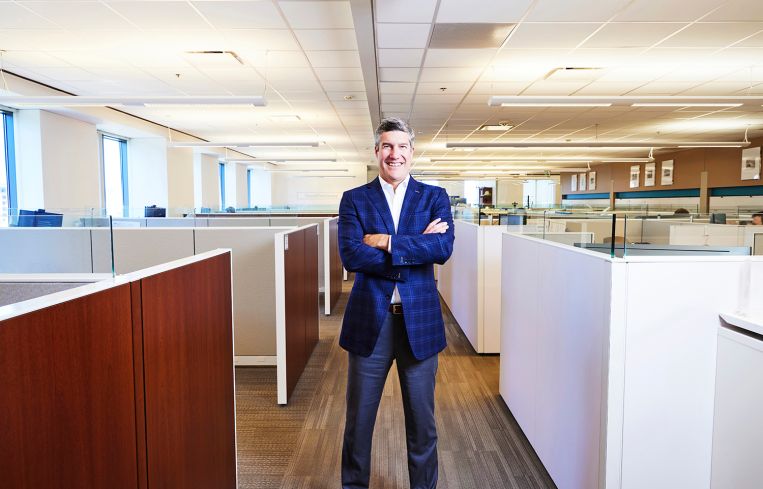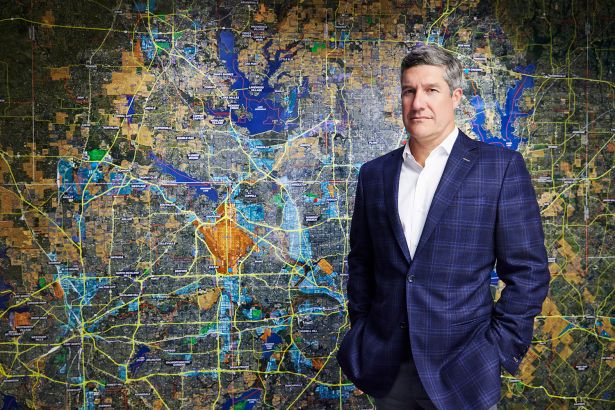Trammell Crow Company’s Adam Saphier On Developing in Texas Post-Pandemic
The Dallas-based firm eschews office in favor of higher-end residential and industrial
By Mark Hallum April 30, 2024 11:00 am
reprints
Trammell Crow Company isn’t just sitting on the fence, they’re hopping in the saddle and going for a ride.
Deep in the Armadillo State, the CBRE subsidiary under the leadership of Adam Saphier, President, Texas as of May 1, is making investments in retail-driven, mixed-use developments and sidestepping the distress in the office market.
Saphier sat down virtually with Commercial Observer in late April, and spoke in detail about how it is executing on its strategies in prime Texas markets where tailwinds such as population growth are making the state a better prospect for real estate even than similarly business-besotted Florida in some ways.
Of Trammell Crow Company’s $18.6 billion in assets under management worldwide, $16.8 billion is in the U.S. and $4.3 billion is in Texas.
Saphier joined Trammell Crow Company in 2005 as part of its office development and investment group in Houston after earning an MBA from the University of Virginia’s Darden School of Business and just prior to the acquisition of the firm by CBRE in 2006.
This interview has been edited for length and clarity.
Commercial Observer: What is one of your top Texas projects under construction at the moment?
Adam Saphier: With our partners [The Retail Connection, Highland Park Village Associates and MSD Partners], we bought land over six years ago and we just broke ground on the Knox District in Dallas at the end of last year, so it was a long due diligence process. It’s 1.7 million gross square feet, a million that’s above grade and 700,000 that is mostly parking below grade. There’s a 140-key, Auberge Resorts Collection hotel called the Knox. Above that there will be 48 luxury condos branded the Knox residences. There’s a 150,000-square-foot boutique office building where the anchor tenant is ISN Software Corporation. There will be a 173-unit, high-end multifamily building with 100,000 square feet of retail.
What I think is unique about it is that there’s going to be a one-acre park in the middle of all that which connects to the Katy Trail, and there are over 2 million visits to that trail every year. Our capital partners are BDT & MSD Partners, and Beal Bank provided the entire $619 million loan.
With construction ready to wrap on the Knox District by 2026, it seems like a fast construction timeline. Are there any major obstacles you deal with in the Texas market?
Each location in Texas is different as it relates to getting the permit to be able to construct so the entitlements can move forward. This one we did aggregates sites and asks for variances to the existing zoning. That was one of the reasons it took so long, and we also took a really long time to design it because we wanted to get it just right.
We have developed within Downtown and Uptown Dallas since we were founded in 1948. So we know a lot of what’s desired and a lot of the stakeholders that we need to go talk to, and how to address their concerns and adapt our project to them if needed. That included the neighbors and the city. It was a process that our team worked very hard to get through over those six years.
Texas has seen a big influx of newcomers from other states since the pandemic, but, in similar states like Florida, you see people actually returning to where they originated. Is that something that Trammell Crow Company is bracing for?
Four million people came to Texas in the last 10 years, 3 million came to Florida and a million came to Georgia. Said another way, 22 percent of the nation’s population growth was in Texas.
My boss, Danny Queenan, runs CBRE’s real estate investment group. He likes to say that we want to develop where the puck is going, not where it is today. So I’m looking backward over the last 10 years, but for us what’s interesting is that we believe the trend is going to keep going. Not just that, but we look for trends in that data. For instance, job growth was 2.2 percent annually versus 1.4 percent for all of the U.S., but, if you look at the last four years in Texas, it was 4.2 percent.
That momentum appears to be growing, which leads us to be very bullish that there will be continued job and population growth in all of Dallas, Houston and Austin going forward.
Tell us about what you’re doing in Austin with 700 River.
So that’s a 43-story, 377-unit luxury apartment building. There is a river that feels like a lake on the south side of Downtown Austin that we believe provides tremendous views and amenities.
Trammell Crow is trying to create projects with as many competitive advantages as possible. This one we do think is different and part of that is some of the amenities that we’ll put in there. There’ll be a full on-site spa, with steam sauna and a cold plunge; I personally love cold plunging. And then there’s an on-site pet care. So, again, this is one example of a very high-price-point, high-end, best-in-class project that we’re trying to deliver.
We want our residences to have a superior outcome for residents and then our tenants for the commercial side. What does that mean, a superior outcome? One way I think of that is that we want them to want to live in our projects — or, on the commercial side, work in our projects — more than anywhere else. And, with that, there has to be a superior value proposition. So that doesn’t mean it has to be the cheapest rate. That means it has to be the best value. And we’re trying to create that value in this product type with competitive advantages.

How does Trammell Crow Company’s industrial strategy play out in Texas?
We consider Dallas one of the gateway industrial markets. It’s roughly 900 million square feet of industrial space, and there are a variety of reasons for that if you just simply think about transportation.
I-35 goes from Mexico to Canada and comes through Dallas-Fort Worth. And I-20 goes almost coast to coast, east to west. We have rail that goes to Southern California from here, and then we’ve got two big airports. So every big mode of transportation other than ships are here, but we can get to them from there.
We’ve got a lot of industrial that serves the Austin market, and then Houston’s somewhere in between. But, like the rest of the country, there’s a tremendous amount of supply that’s hitting in Texas and that’s the same for the whole U.S. Industrial construction takes roughly up to 12 months from start to finish. So, while that supply is robust, what I call the development spigot is being turned off. If you look at all industrial starts nationally, they’re down about 69 percent year-over-year.
It’s also relevant to say interest rates have been going up for a couple years. So let’s compare starts now to the 10-year average, and starts are down about 61 percent. So there’s a material amount of development that’s decreasing. While the supply is hitting in Texas and everywhere else, there’s not much behind it. There’ll be time for that supply to get absorbed.
How have interest rates impacted your development pipeline?
It is harder to underwrite projects. Both from the short-term interest rates that have gone up, which makes the construction loans more expensive, and the longer end of the curve like the 10-year treasury, which makes permanent financing more expensive also. All of this means it’s harder to start new projects because we require a higher yield on cost — the return on the cost of the project has gone up.
In the aggregate, our construction pipeline was down about 40 percent in 2023 versus 2022, so we were down but not as much as the rest of the country. And we think part of the reason for that is we have great capital partners. We have a capital markets group solely dedicated to managing expectations in our field and for our capital partners. They make sure we’re aligning the best equity partners and the best lenders to our projects based on what their needs are, and we have a very diversified pool. We have roughly 30 equity partners in our deals today, and I think about 35 or 36 lenders.
Trammell Crow Company seems to have very little exposure to the downturn in office, but you do develop some office properties. How have you managed to avoid distress?
Unlike a real estate investment trust or other investment vehicles, we don’t have long-term holdings in office. We do have clients that still want new, great office buildings, so we’re constructing primarily build-to-suits. If you went back to pre-COVID from 2006, when CBRE acquired us, to 2020, we were averaging about six office development starts a year — about three build-to-suits for clients and three speculative projects.
What is the future of Trammell Crow Company’s development pipeline in Texas and what markets do you want to reach?
We want to be developing in all the cities that in the past Trammell Crow has developed in — Dallas, Houston, Austin and San Antonio — and as far as El Paso.
Mark Hallum can be reached at mhallum@commercialobserver.com.


